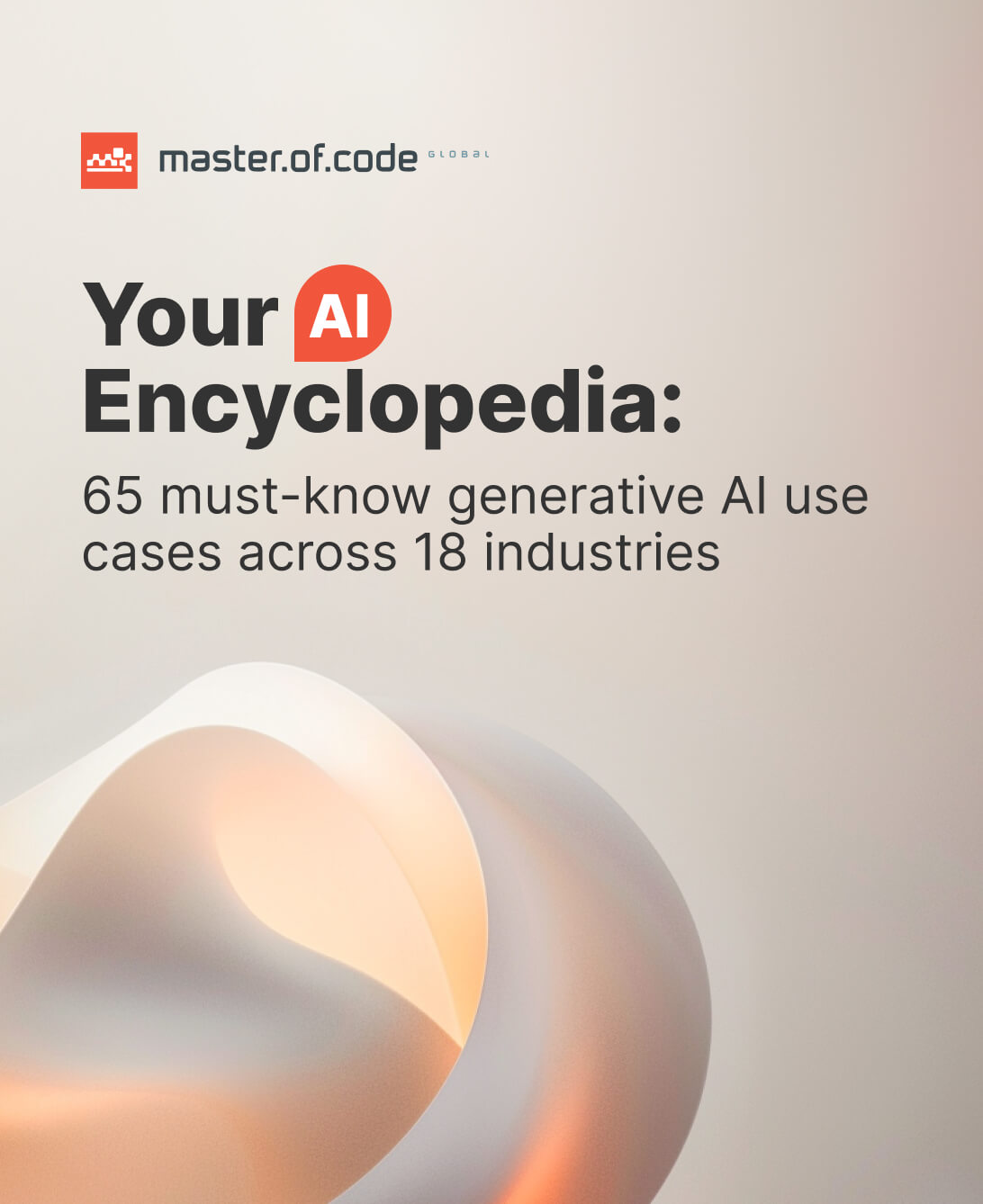A wellness provider increased conversions by 22%. A telecom company cut handling times by 18% and boosted satisfaction by 10 NPS points. You don’t get results like these by luck. They come from structured review and thoughtful conversational design.
Ultimately, expert-led AI agent evaluation ensures that performance is not based on assumptions but on data. It helps teams identify where the tool succeeds, where users struggle, and what changes actually move the needle in response quality, cost efficiency, and overall task success.
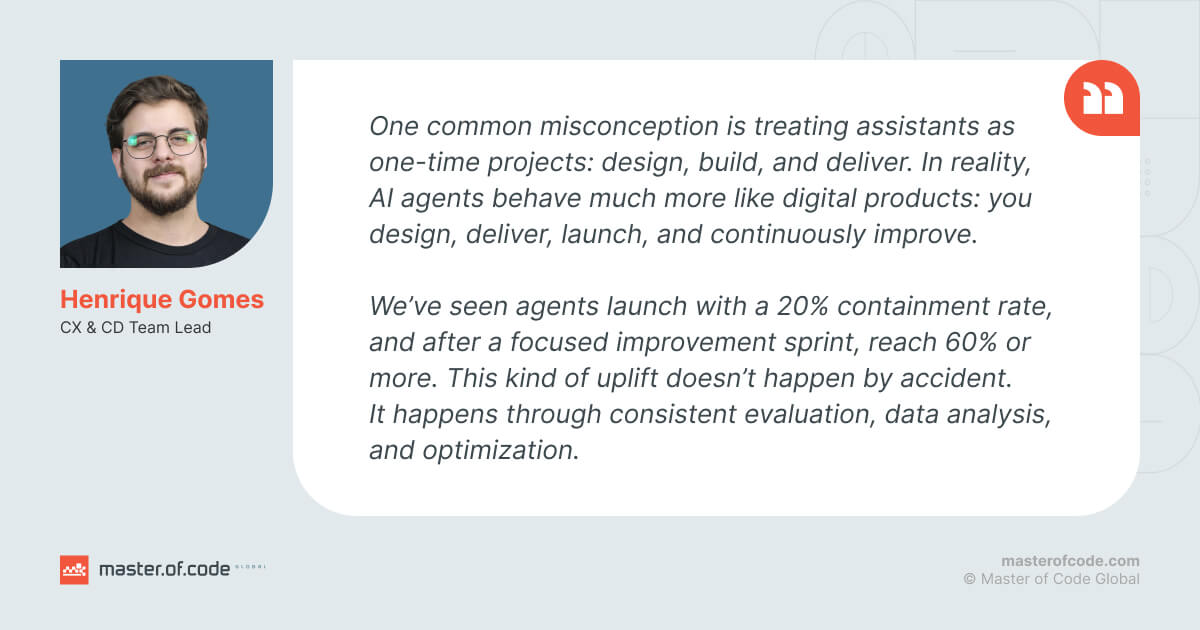
We’ve asked Henrique Gomes, CX & CD Team Lead at Master of Code Global, to share his practical perspective on where and how this process drives measurable impact.
So stay with us as we break down everything you need to know about evaluating your intelligent apps the right way.
Table of Contents
Overview: A High-Level Look at AI Agent Evaluation
If this process is so critical, when should it happen? And what exactly should teams measure? Here is how Henrique Gomes explained it to us.
When it comes to evaluating AI agents, this is not just an afterthought or a “nice to have” step — it’s an indispensable bridge between the Discovery and the Post-Launch Optimization phase of the full development cycle.
During the Agentic AI PoC, teams should already define which key KPIs (key performance indicators) will drive the assessment. Once the solution is launched and real users start interacting with it, those metrics become actionable data. This is when evaluation truly begins.
Every advanced intelligent software — no matter how well designed — will require a post-launch optimization cycle. This is the phase where professionals extract and analyze usage data to uncover patterns, identify gaps, and propose evidence-driven improvements. It’s not optional; it’s essential for scaling impact and ROI.
Core AI Agent Evaluation Metrics 2025
To structure this analysis, we typically look at four main categories:
1. Goal Fulfillment
- Containment Rate: % of users who resolve their issue through the assistant without needing other support channels.
- Completion Rate: % of users who successfully complete a defined process.
2. User Satisfaction
- Net Promoter Score (NPS): User rating from 1 to 10, indicating how likely they are to recommend the service.
- Customer Satisfaction Score (CSAT): How satisfied the client is with the interaction.
3. Response Quality
- Confusion Triggers: % of interactions where the algorithm doesn’t know how to respond.
- One-Answer Success Rate: % of conversations resolved in a single exchange.
- Feedback Ratings: Positive response rates to “Did I help you?” prompts.
- Confidence Score and Hallucination Detection: Key for LLM-powered interfaces.
4. Usage
- Users and interactions over time;
- Average interactions per session;
- Session duration;
- Most and least used intents, entities, topics, and flows.
For LLM-based tools, it’s also crucial to track Cost, Latency, Prompt Injection Vulnerability, and Policy Adherence Rate.
While all metrics are valuable, Goal Fulfillment is often the best indicator of how much the AI agent is driving real business outcomes. It measures the solution’s ability to help users achieve what they came for and ultimately, to ensure value for the organization.
One common misconception is treating these systems as one-time projects: plan, build, and roll out. In reality, agents behave much more like digital products: you design, deliver, launch, and continuously improve.
And this improvement should be grounded in data. A practical starting point is to analyze the flows with the highest adoption, evaluate their completion and satisfaction rates, and identify drop-off points. Based on these findings, teams can iterate and optimize.
We’ve seen agents launch with a 20% containment rate, and after a focused modification sprint, reach 60% or more. This kind of uplift doesn’t happen by accident. It happens through consistent evaluation, data analysis, and optimization.
Now that we’ve covered the essentials, let’s dive into how assessment is actually carried out and the metrics that make it measurable.
Why AI Performance Review Matters More Than You Think
Evaluation is a structured process for verifying how an implementation performs under real conditions, not just in controlled testing. It determines whether the system delivers consistent, accurate, and efficient results once deployed at scale.
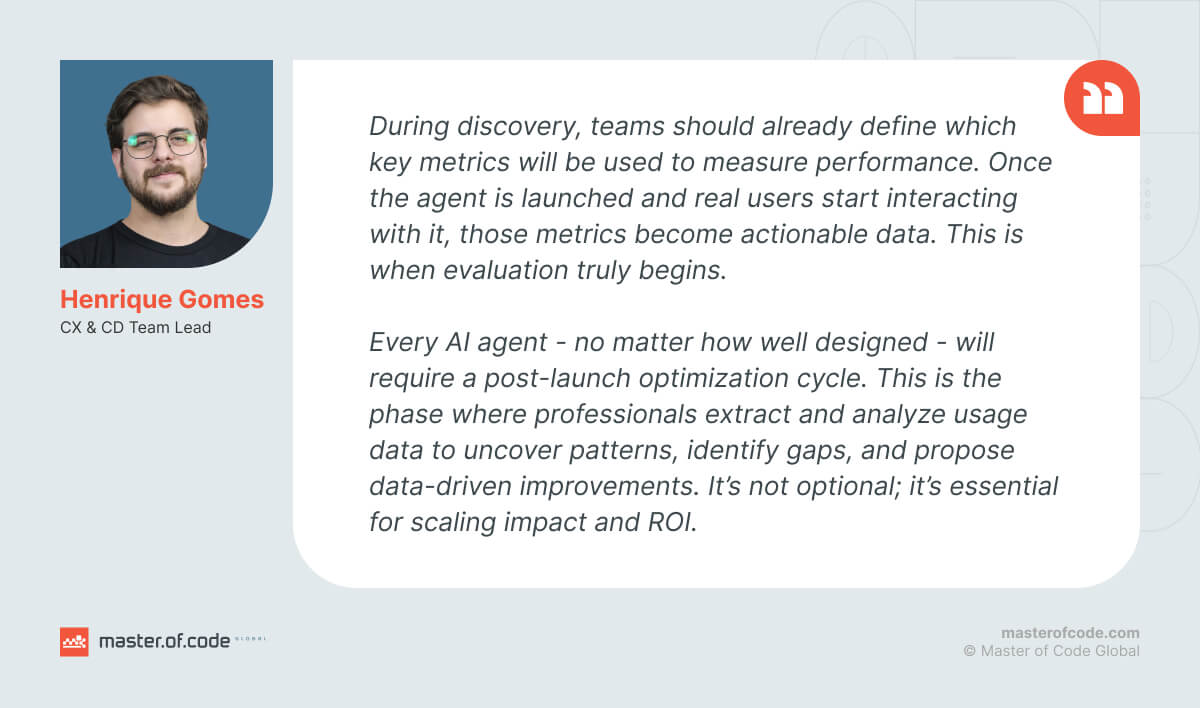
A well-designed agent can appear effective in simulation yet struggle when exposed to live traffic, ambiguous queries, or changing user intent. Appraisal enables teams to understand where the AI operates as expected and where it falls short.
1. Measuring Real Performance
Evaluation confirms whether the agent achieves its intended goals. For example, a customer service assistant may look accurate during training but achieve only a 45% containment rate after launch. Such findings guide improvements to language understanding, response routing, or integration coverage before issues affect all users.
2. Identifying Gaps and Weak Points
Consistent analysis reveals where the system encounters friction. High fallback rates, repeated escalations, or incomplete workflows point to inefficiencies in design or training. By addressing these early, teams improve both reliability and user confidence.
3. Supporting Continuous Improvement
Intelligent systems evolve through iteration. Ongoing review creates a feedback cycle where every update is measured against actual impact. Numbers show that regular model updates can boost prediction accuracy by 18–32% compared to static models trained only once.
4. Setting Standards Through Benchmarking
Evaluation establishes reference points for comparison. Benchmarks help determine whether the agent meets internal expectations and aligns with industry norms. As an illustration, enterprise conversational systems often aim for containment rates of 70–90%, while simpler FAQ bots average closer to 40–60%.
5. Balancing Efficiency and Cost
Performance alone does not define success. Efficient operation (reflected in cost per interaction, latency, and resource use) matters equally. Continuous tracking allows organizations to refine infrastructure and reduce operational overhead while maintaining quality.
Agentic systems evaluation, in essence, offers a practical way to measure impact, prioritize improvements, and sustain user trust over time. Next, we will look at how this process is carried out in practice: the metrics, frameworks, and timing.
What AI Agent Evaluation Metrics to Measure at Each Stage
This procedure is not a single-stage activity but a continuous cycle that adapts as the solution matures. What teams calculate before launch differs from what matters after users begin interacting with the interface.
A structured approach ensures that data is collected at the right time, using metrics aligned with both performance and business goals.
1. Pre-Launch: Functional and Reliability Testing
Before deployment, the focus is on validating whether the agent performs as designed. The targets comprise:
- Intent and entity accuracy: Measures how well the model understands user inputs.
- Flow coverage: Confirms that all dialogue paths and decision branches work as intended.
- Error recovery rate: Tracks whether the system can handle incomplete or ambiguous queries without breaking.
Pre-launch evaluation is often iterative. Teams adjust training data, fine-tune model parameters, and re-test flows until the algorithm demonstrates consistent baseline effectiveness.
2. Post-Launch: Performance and UX
Once live traffic begins, attention shifts toward how real users interact with the system. At this phase, it becomes clear how the tool operates and how it handles real service conditions.
Key measurements include:
- Containment rate: How many users complete their goals without escalation.
- Response latency: How quickly the system replies under typical and peak loads.
- User satisfaction (CSAT/NPS): Direct feedback indicating perceived quality and usefulness.
Monitoring this data over the first few weeks provides the clearest insight into usability issues, unmet intents, or latency spikes that were not evident during testing.
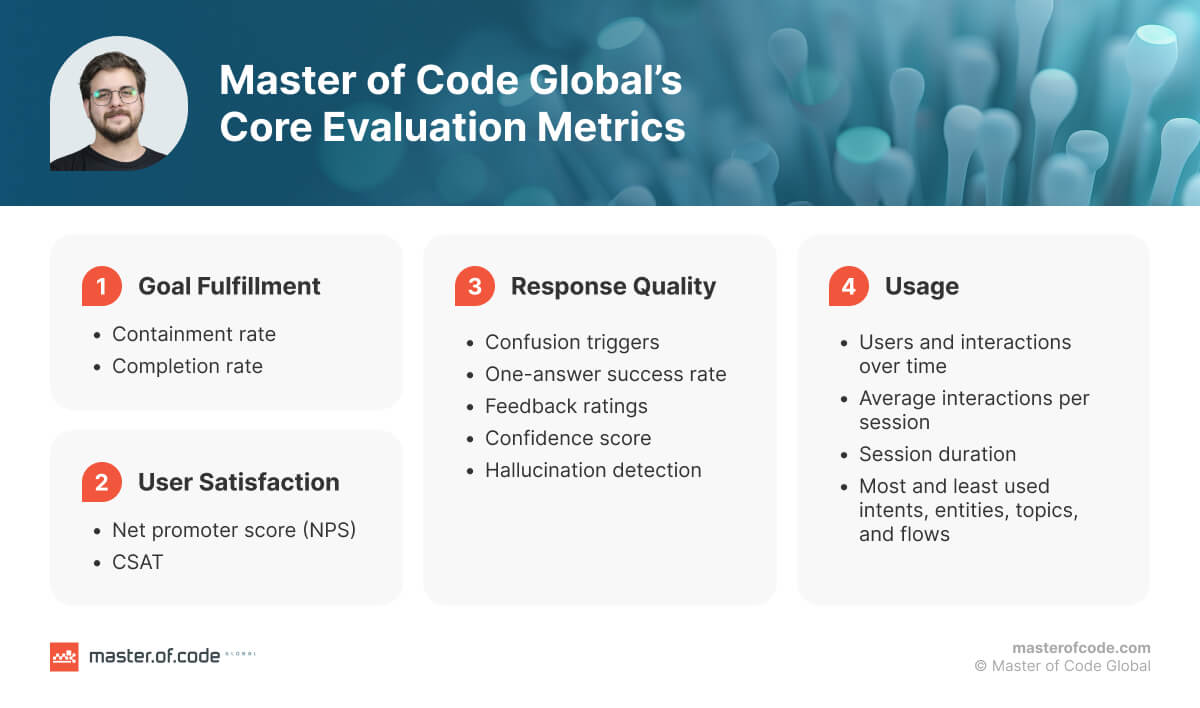
3. Optimization Phase: Behavioral and Contextual Evaluation
As usage grows, the goal becomes understanding how the solution behaves across different user segments, channels, and tasks, specifically monitoring metrics for AI agent consistency.
Areas of analysis are:
- Context retention: How well the model maintains relevant setup across turns.
- Escalation accuracy: Whether it hands off to human support at the right time.
- Consistency and stability: Whether responses remain coherent across repeated queries.
During this phase, data science teams often introduce anomaly detection and drift monitoring. These identify shifts in input types or user behavior that degrade performance over time.
4. Continuous Monitoring: Efficiency and Compliance
Regular oversight concentrates on optimizing operations and upholding compliance requirements. This gains importance when the agent is involved in core business functions.
Common parameters include:
- Cost per interaction: Balancing model size, token use, and infrastructure expenses.
- Throughput: Measuring total queries handled per minute or hour.
- Policy adherence rate: Ensuring responses follow security, privacy, and brand guidelines.
- Prompt injection or misuse detection: Identifying manipulation attempts or unsafe outputs.
This ongoing evaluation ensures the system remains aligned with technical and ethical standards as both usage and regulatory landscapes evolve.
5. Specialized Cases: Voice and Multimodal Implementations
Assessing multimodal and speech-enabled solutions involves additional dimensions. AI voice agent performance evaluation metrics must reflect human conversation standards:
- Word Error Rate (WER): Acceptable scope typically falls below 5%.
- Mean Opinion Score (MOS): Evaluates naturalness and clarity; near-human systems average 4.5/5 or higher.
- Voice latency: The end-to-end delay should stay under 800 milliseconds for a natural experience.
For multiple modalities, the focus includes:
- Tool selection accuracy: Whether the agent correctly invokes functions or APIs.
- Multistep reasoning success rate: How consistently the system completes multi-action workflows.
- Cross-modal alignment: Precision when combining text, visual, or tabular inputs.
Each stage serves a different purpose:
- Before launch: validate readiness.
- After launch: measure real-world performance.
- Over time: ensure stability, cost control, and trust.
Assessing the right indicators at the right moment allows teams to manage AI agents as living systems rather than static deployments. Next, we’ll look at how to organize these activities within a repeatable structure.
Building a Robust AI Agent Evaluation Framework
A systematic approach ensures that every improvement is based on measurable evidence rather than guesswork. The goal is to turn performance tracking into a consistent process that supports both technical optimization and business outcomes.
The framework typically follows five iterative steps.
1. Define: Establish Clear Objectives
Start by aligning on what success means for the organization.
Teams should specify primary KPIs (such as containment rate, response accuracy, or cost per interaction). Next goes connecting each to a business goal: reducing support volume, increasing conversion, or improving satisfaction.
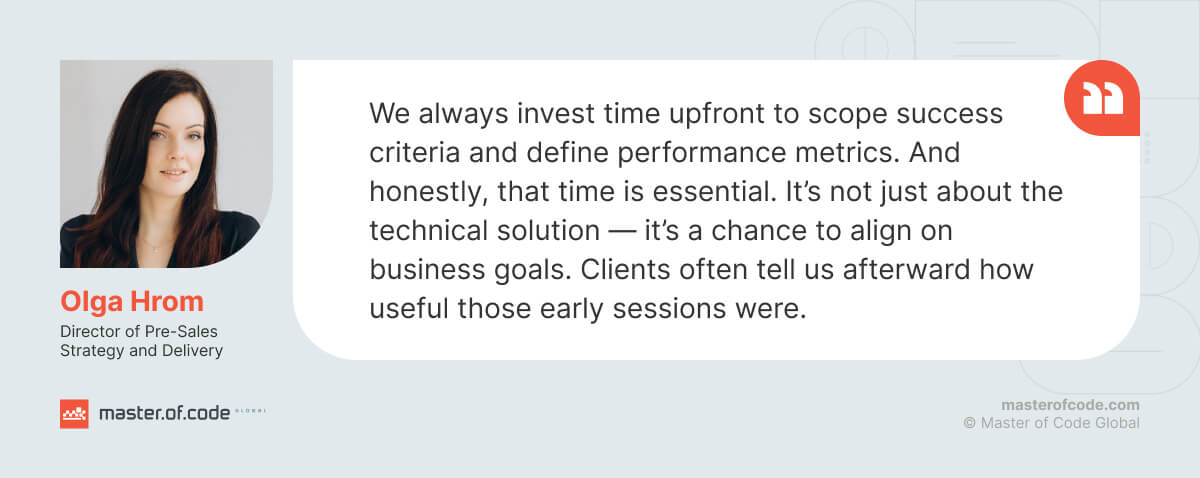
At this stage, stakeholders agree on data sources, sample sizes, and acceptable performance thresholds. Without this foundation, later analysis risks becoming inconsistent or incomplete.
2. Collect: Build Representative Data
This should cover both synthetic and real examples, reflecting typical requests, edge cases, and outlier scenarios. Logs from production systems often serve as the most valuable input because they reveal actual user behavior.
All datasets should be labeled consistently and anonymized to comply with data protection standards such as GDPR or HIPAA, when relevant.
3. Test: Measure and Validate
This step involves both automated testing (rule- or model-based scoring) and manual review for subjective dimensions such as tone, clarity, or contextual understanding.
Regression testing ensures that recent updates have not introduced new errors. For voice or multimodal agents, tests should include latency measurement and channel-specific accuracy checks.
4. Analyze: Identify Patterns and Priorities
Once results are collected, teams interpret the data to determine what drives success or failure. Metrics such as response accuracy, completion rate, and cost are analyzed together rather than in isolation. For example, a 2% gain in accuracy may not justify a 40% increase in compute expense.
Visualization tools or internal dashboards help detect trends (recurring failure modes or declining performance on specific intents), guiding the next round of optimization.
5. Iterate: Improve and Re-Evaluate
Insights from analysis inform model retraining, flow redesign, or policy updates. The same metrics are then re-measured to verify progress. Teams can use version tracking or Continuous Integration and Continuous Deployment to automate this process. Such an approach ensures that every deployment undergoes objective validation before release.
Design for Measurement
A reliable framework depends on one principle: metrics-driven from day one. This means defining success criteria during discovery, embedding instrumentation in each workflow, and maintaining transparent documentation on what is being tracked and why.
Aligning KPIs with business outcomes guarantees that evaluation does not remain a technical exercise. Improvements in containment, latency, or satisfaction should directly support measurable ROI, compliance, or customer experience goals.
When implemented consistently, this lifecycle transforms from a reactive task into a structured feedback system that drives long-term performance and accountability.
Next, we will look at the standards and mechanisms that make these processes consistent and scalable across modern systems.
Overview of Top AI Agent Evaluation Benchmarks
By 2025, assessment has matured into a standardized practice supported by well-defined testing suites and specialized monitoring platforms. These instruments allow teams to validate both tech performance and user-facing quality with repeatable, data-backed methods.
Standardized Benchmarks
- AlpacaEval. Used for language model and instruction-following quality, it tests response relevance, factual consistency, and coherence.
- GAIA (General AI Assistant Benchmark). It simulates complex, real-world queries that require step-by-step planning. GAIA helps measure how well a solution combines reasoning, retrieval, and task execution.
- LangBench. Focused on conversational and task-oriented agents, LangBench measures goal completion, context retention, and error recovery. It’s widely employed for validating custom LLM software that operates across multiple domains.
- OpenAI Evals. An open-source framework for running targeted evaluations at scale. Teams can define their own test datasets, automate comparisons between models, and log metric evolution through each iteration.
Evaluation Tools and Platforms
- Galileo AI. Offers model review without requiring labeled reference data. Its chain-based scoring and drift detection help identify quality degradation before it impacts users. Galileo is used for large-scale, production-grade monitoring.
- LangSmith (LangChain). Tailored for LangChain or LangGraph-based applications, it delivers detailed trace logs, step-by-step replay, and output scoring. It’s ideal for diagnosing logic errors in agent workflows.
- Patronus AI. Specializes in hallucination and safety detection. It identifies factual errors, bias, and policy violations in real time, supporting compliance-critical use cases in finance or healthcare.
- DeepEval (Confident AI). An open-source toolkit that focuses on transparency and reproducibility. It integrates directly into development pipelines and supports regression testing for reasoning, factuality, and consistency.
- Langfuse. Provides evaluation and observability capabilities with a focus on cost tracking and performance visualization. It allows teams to customize metrics, connect multiple data sources, and maintain granular audit trails.
Together, these create a complete feedback loop where evaluation data moves seamlessly from test environments to live systems. Next, we’ll cover how to ensure this process stays predictable and trustworthy over time.
Strategies for Reliable Evaluation and Continuous Improvement
To stay effective, the assessment approach must evolve with changing data, user behavior, and model updates. Below are the methods that guarantee results remain consistent and actionable across the full lifecycle of an AI solution.
1. Multi-Agent Validation
When multiple tools or models work together, the review should confirm both individual and collective reliability. Validation includes checking how algorithms share data, resolve conflicts, and complete collaborative tasks.
For example, retrieval and reasoning agents should produce consistent outputs even when tested separately. Cross-validation runs under identical prompts to help detect instability or dependency issues between components.
2. A/B Testing in Live Environments
Two versions of an agent, such as a baseline and an updated model, are exposed to comparable traffic. Teams then analyze differences in key metrics like completion rate, latency, or user satisfaction.
Running controlled tests in production environments allows organizations to verify whether new features or prompt updates genuinely improve outcomes without disrupting operations. Short testing windows (one to two weeks) are usually sufficient to identify statistically meaningful trends before full rollout.
3. Segment-Specific Performance Tracking
User behavior and output often vary by channel, region, or type. Segmenting evaluation results reveals whether the agent performs equally across all contexts or favors specific ones. For example, customer support interfaces may show higher containment in English interactions than in Spanish or French due to training bias. Identifying these disparities early helps teams adjust language models, localization strategies, or domain data coverage.
4. Periodic Optimization Cadence
High-performing teams follow a methodical assessment schedule and retraining, typically:
- Weekly: quick health checks on latency, cost, and error rates.
- Monthly: deep dives into goal fulfillment and user satisfaction.
- Quarterly: comprehensive regression testing and model tuning.
This rhythm balances speed and depth. It ensures that issues are caught early while still allowing meaningful trend analysis over time.
5. Continuous Monitoring and Alerts
Automated oversight systems capture real-time data on quality, safety, and efficiency. Dashboards visualize trends, while alerts signal deviations beyond acceptable thresholds. These may be a sudden latency increase or drop in containment rate. When integrated into CI/CD pipelines, such a setup creates an ongoing safeguard: any performance drift or compliance issue triggers immediate review.
6. Incorporating Human Oversight
Even the best automation benefits from periodic manual inspection. Human-in-the-loop assessments identify subtleties (tone mismatches, misleading phrasing, or ethical oversights) that models or scripts may miss.
Many organizations aim for a hybrid approach: around 80% automated evaluation complemented by 20% expert review. This combination maintains scalability while preserving judgment and accountability.
Overall, teams that pair automation with selective human review can detect shifts early, prioritize the right improvements, and keep their agents aligned with user needs and business goals as conditions evolve. Let’s next look at how these strategies translate into measurable outcomes through Master of Code Global’s practical experience.
How AI Agent Performance Evaluation Metrics Looks in Practice
At Master of Code Global, evaluation is built into every stage of delivery — from development to post-launch optimization. These two examples show how data-led iteration improves both performance and business outcomes.
Case #1: GenAI for Customer Onboarding
Problem
A major wellness services provider faced declining conversion rates. Visitors reached the website but often dropped off before creating an account or booking an appointment. Expanding live agent support wasn’t sustainable, and simple chatbots couldn’t handle complex user journeys.
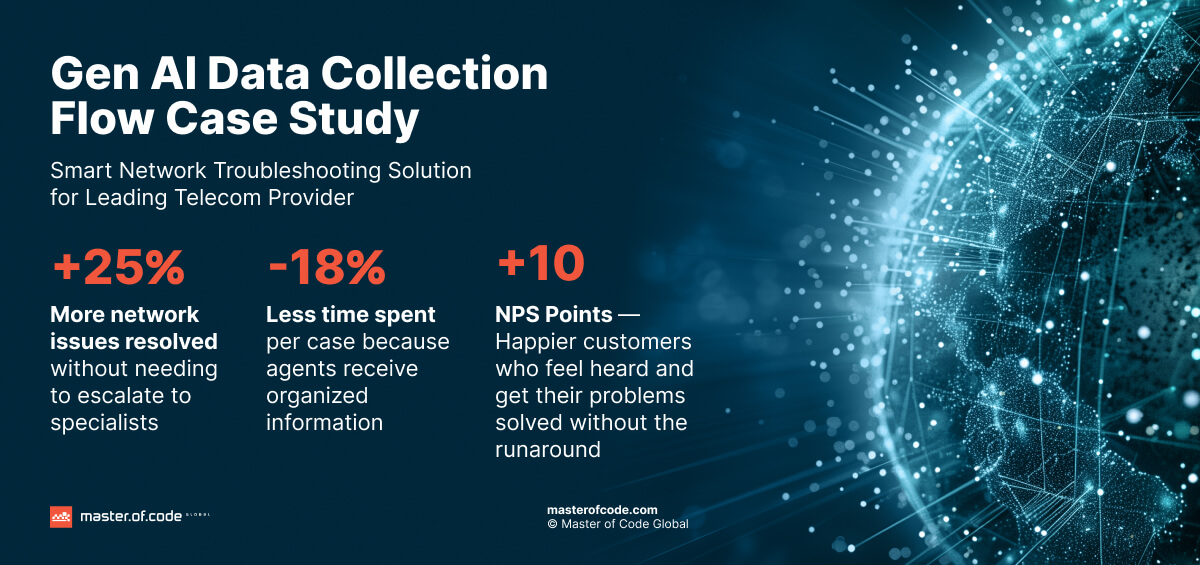
Solution
Master of Code Global built a GenAI-powered onboarding agent that guides visitors through account setup, provider matching, and booking. It uses Conversational AI to understand context, personalize responses, and proactively help users complete their journey without switching channels.
What We Measured
- Conversion rate (visitor-to-lead and lead-to-buyer);
- Customer acquisition cost;
- Engagement success rate (completion of onboarding flow).
Results
- +22% increase in conversion;
- –17% reduction in client acquisition expenses;
- +20% improvement in engagement success rate.
Case #2: GenAI Data Collection Flow
Problem
A leading telecom provider struggled with long handling times and repeated diagnostic questions. Customers had to explain issues multiple times, and employees spent too much time collecting basic data instead of solving complex problems.
Solution
Master of Code Global created a GenAI data collection flow that assists agents during network troubleshooting. The AI gathers key diagnostic information through natural conversations, understands unstructured input, and passes complete data to managers for faster resolution.
What We Measured
- Bot containment rate (cases solved without escalation);
- Average handling time;
- Client satisfaction (NPS).
Results
- +25% more network issues resolved without escalation;
- –18% shorter handling times;
- +10 NPS points increase in customer satisfaction.
Both results were driven by the same principle: measure, learn, improve, and repeat. Henrique Gomes, our CX & CD Team Lead, described it simply:
“We achieved those numbers by designing with a clear focus on user needs and business goals. And just as important, after launch we invested in continuous optimization: improving prompts, reducing drop-offs, and increasing containment and satisfaction. The real impact comes when you keep improving the experience based on real user feedback.”
In the End…
A reliable review process keeps agentic solutions useful and accountable. It helps teams understand how real users interact, where systems underperform, and which changes actually make a difference. The right AI agent evaluation metrics turn daily usage data into measurable improvements: faster responses, fewer escalations, and lower operational costs.
Imagine having those insights available after every update. Instead of guessing what works, you can track it, compare it, and act on it. That’s what separates projects that plateau from those that evolve.
Through our Agentic AI consulting services, we enable companies to set clear KPIs, collect the right data, and close the loop between performance and business outcomes. If you want your next initiative to show trackable results from the start, contact our team, and we’ll help you build an evaluation framework that works for you.


